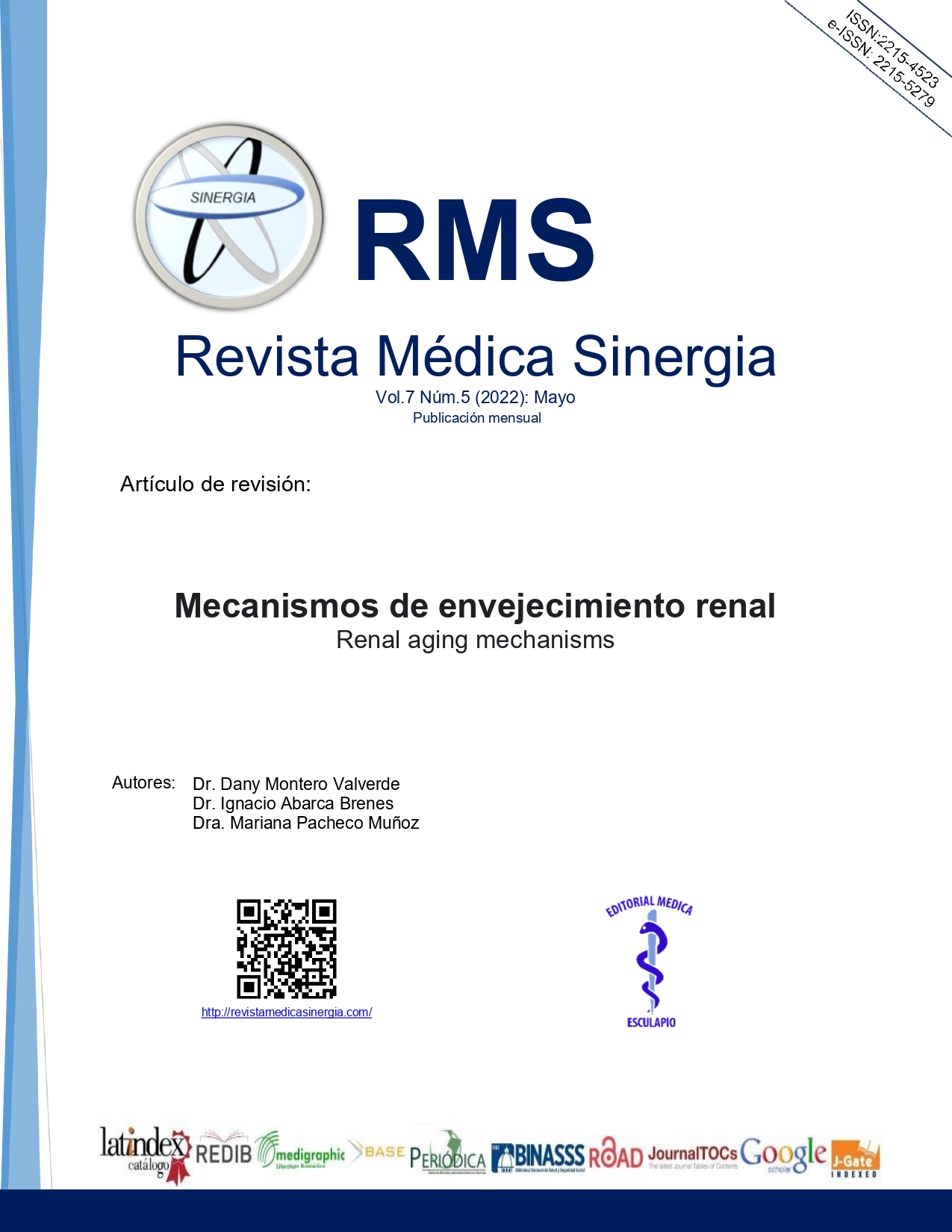Resumen
Los riñones son de los órganos que sufren más cambios durante el envejecimiento. Existe una serie de mecanismos involucrados en el proceso de senescencia renal que explican los cambios estructurales, funcionales y moleculares que suceden intrínsecamente en este órgano. Uno de los más estudiados es el gen Klotho, cuya disminución favorece que los procesos dañinos conlleven a arteriosclerosis y la progresión de daño renal permanente. Otros mecanismos detallados en esta revisión incluyen el factor de crecimiento fibroblástico 23, la senescencia celular, el acortamiento de telómeros, la inflamación crónica y la señalización Wnt que suele estar sobreexpresada durante el envejecimiento.Comprender estos mecanismos favorecerá a futuro la implementación de diferentes intervenciones para detener o enlentecer la fibrosis y esclerosis que se desarrolla en los adultos mayores conforme aumenta la edad.
Palabras clave
Citas
O’Sullivan ED, Hughes J, Ferenbach DA. Renal aging: Causes and consequences. J Am Soc Nephrol [Internet]. 2017;28(2):407–20. doi: http://dx.doi.org/10.1681/ASN.2015121308
Li Z, Wang Z. Aging kidney and aging-related disease. Adv Exp Med Biol [Internet]. 2018;1086:169–87. doi: http://dx.doi.org/10.1007/978-981-13-1117-8_11
Kuro-O M. The Klotho proteins in health and disease. Nat Rev Nephrol [Internet]. 2019;15(1):27–44. doi: http://dx.doi.org/10.1038/s41581-018-0078-3
Buchanan S, Combet E, Stenvinkel P, Shiels PG. Klotho, aging, and the failing kidney. Front Endocrinol (Lausanne) [Internet]. 2020;11. doi: http://dx.doi.org/10.3389/fendo.2020.00560
Drew DA, Katz R, Kritchevsky S, Ix JH, Shlipak MG, Newman AB, et al. Fibroblast growth factor 23: A biomarker of kidney function decline. Am J Nephrol [Internet]. 2018;47(4):242–50. doi: http://dx.doi.org/10.1159/000488361
Wei S-Y, Pan S-Y, Li B, Chen Y-M, Lin S-L. Rejuvenation: Turning back the clock of aging kidney. J Formos Med Assoc [Internet]. 2020;119(5):898–906. doi: http://dx.doi.org/10.1016/j.jfma.2019.05.020
Schmitt R, Melk A. Molecular mechanisms of renal aging. Kidney Int [Internet]. 2017;92(3):569–79. doi: http://dx.doi.org/10.1016/j.kint.2017.02.036
Valentijn FA, Falke LL, Nguyen TQ, Goldschmeding R. Cellular senescence in the aging and diseased kidney. J Cell Commun Signal [Internet]. 2018;12(1):69–82. doi: http://dx.doi.org/10.1007/s12079-017-0434-2
Gekle M. Kidney and aging — A narrative review. Exp Gerontol [Internet]. 2017;87:153–5. doi: http://dx.doi.org/10.1016/j.exger.2016.03.013
Kidir V, Aynali A, Altuntas A, Inal S, Aridogan B, Sezer MT. Telomerase activity in patients with stage 2–5D chronic kidney disease. Nefrologia [Internet]. 2017;37(6):592–7. doi: http://dx.doi.org/10.1016/j.nefro.2017.03.025
Patel S, Rauf A, Khan H, Abu-Izneid T. Renin-angiotensin-aldosterone (RAAS): The ubiquitous system for homeostasis and pathologies. Biomed Pharmacother [Internet]. 2017;94:317–25. doi: http://dx.doi.org/10.1016/j.biopha.2017.07.091
Choudhury D, Levi M. Kidney aging--inevitable or preventable? Nat Rev Nephrol [Internet]. 2011;7(12):706–17. doi: http://dx.doi.org/10.1038/nrneph.2011.104
Paz Ocaranza M, Riquelme JA, García L, Jalil JE, Chiong M, Santos RAS, et al. Counter-regulatory renin-angiotensin system in cardiovascular disease. Nat Rev Cardiol [Internet]. 2020;17(2):116–29. doi: http://dx.doi.org/10.1038/s41569-019-0244-8
Li XC, Zhang J, Zhuo JL. The vasoprotective axes of the renin-angiotensin system: Physiological relevance and therapeutic implications in cardiovascular, hypertensive and kidney diseases. Pharmacol Res [Internet]. 2017;125:21–38. doi: http://dx.doi.org/10.1016/j.phrs.2017.06.005
Yang T, Xu C. Physiology and pathophysiology of the intrarenal renin-angiotensin system: An update. J Am Soc Nephrol [Internet]. 2017;28(4):1040–9. doi: http://dx.doi.org/10.1681/ASN.2016070734
Wang Y, Zhou CJ, Liu Y. Wnt signaling in kidney development and disease. Prog Mol Biol Transl Sci [Internet]. 2018;153:181–207. doi: http://dx.doi.org/10.1016/bs.pmbts.2017.11.019
Zuo Y, Liu Y. New insights into the role and mechanism of Wnt/β-catenin signalling in kidney fibrosis: Wnt/β-catenin and kidney fibrosis. Nephrology (Carlton) [Internet]. 2018;23 Suppl 4:38–43. doi: http://dx.doi.org/10.1111/nep.13472
Li Z, Zhou L, Wang Y, Miao J, Hong X, Hou FF, et al. (pro)renin receptor is an amplifier of Wnt/β-catenin signaling in kidney injury and fibrosis. J Am Soc Nephrol [Internet]. 2017;28(8):2393–408. doi: http://dx.doi.org/10.1681/ASN.2016070811
Chen D, Xie R, Shu B, Landay AL, Wei C, Reiser J, et al. Wnt signaling in bone, kidney, intestine, and adipose tissue and interorgan interaction in aging. Ann N Y Acad Sci [Internet]. 2019;1442(1):48–60. doi: http://dx.doi.org/10.1111/nyas.13945
Miao J, Liu J, Niu J, Zhang Y, Shen W, Luo C, et al. Wnt/β-catenin/RAS signaling mediates age-related renal fibrosis and is associated with mitochondrial dysfunction. Aging Cell [Internet]. 2019;18(5):e13004. doi: http://dx.doi.org/10.1111/acel.13004
Zhou G, Li J, Zeng T, Yang P, Li A. The regulation effect of WNT-RAS signaling in hypothalamic paraventricular nucleus on renal fibrosis. J Nephrol [Internet]. 2020;33(2):289–97. doi: http://dx.doi.org/10.1007/s40620-019-00637-8

Esta obra está bajo una licencia internacional Creative Commons Atribución-NoComercial 4.0.
Derechos de autor 2022 Array


